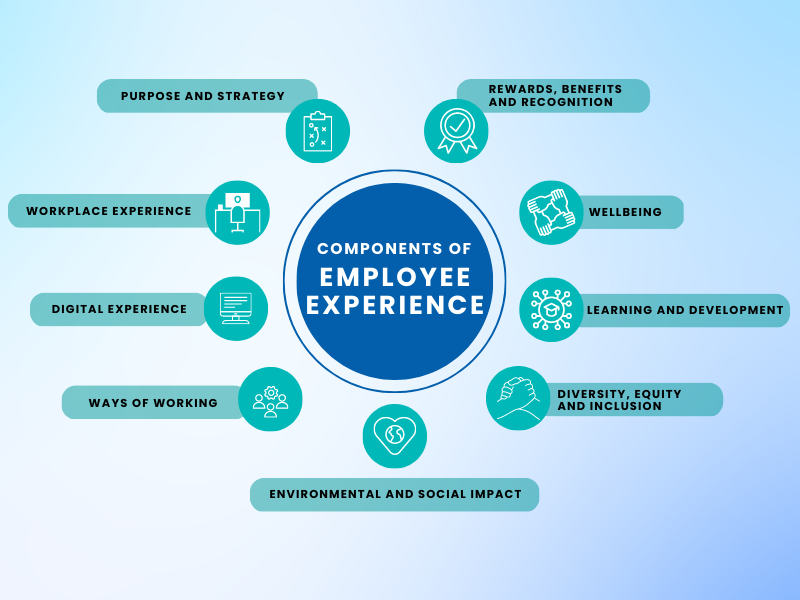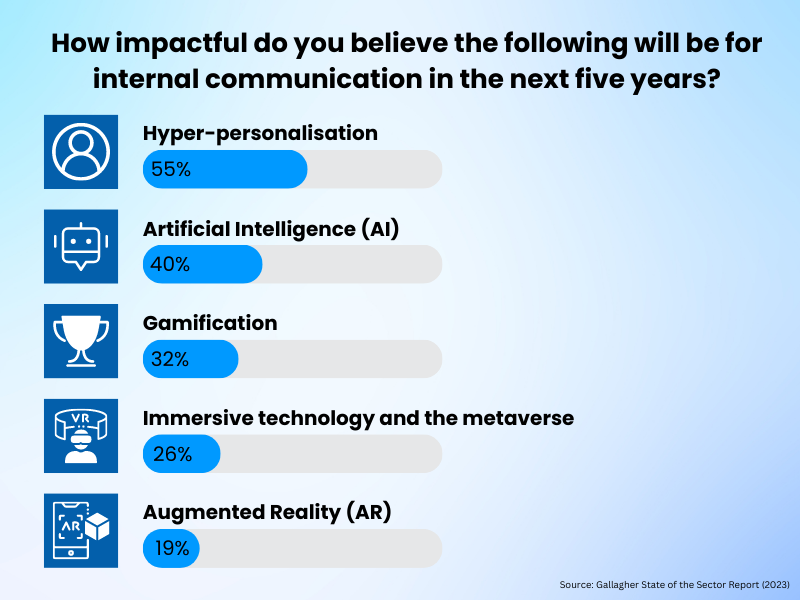From the latest State of the Sector Report from Gallagher, organisations seem to have taken hybrid working into stride, making it their new reality.
Among other initiatives, the focus for internal communicators in 2023 will be about refreshing internal communications strategy, defining what the employee-employer relationship looks like to their organisation – especially relevant moving on from The Great Resignation and helping employees realise the benefits beyond the pay check – and prioritising culture and belonging. Read on to find out more about what’s on the horizon for the internal communications sector in 2023.
Contents
- Culture and belonging
- Employee experience
- Navigating uncertainty
- Communication channels
- Benchmark your practices
Taking the pulse of the state of internal communications in 2022/23
What’s the purpose of internal communication in organisations?
- For organisations with more than 5,000 employees, 28% believe the primary purpose of internal communication is strategic alignment (creating clarity around your strategy and create a sense of ownership), closely followed by culture and belonging (creating an inclusive workplace where employees feel valued and energised).
- For organisations with less than 5,000 employees, culture and belonging are the main purpose of internal communication.
- Organisational agility (supporting the adoption of new behaviours, systems and processes) ranked third across all organisations regardless of size.
What topics are internal communicators focused on?
- 45% were focused on strategy, vision and purpose
- 29% on diversity, equity and inclusion
- Value, behaviours and culture, and wellbeing and mental health sat side by side at 27%
- Smaller organisations were more likely to focus on benefits, rewards and compensation, and employee recognition, while larger organisations stress ways of working and customer experience
In 2023, what are internal communicators’ top priorities and challenges?
- 51% of respondents prioritise engaging teams around purposes, strategy and values
- 35% developing or refreshing internal communications strategy
- 32% enhancing people manager communication
Top challenges for internal communicators in 2023
- 34% cite a lack of time and capacity in their team
- 30% foresee struggles with disengaged employees
- 24% face a lack of budget. However, this isn’t so much of an issue for larger organisations, perhaps due to economy of scale
- Larger organisations of up to 10,000 employees are concerned about the lack of analytics and the volume of communications
Culture and belonging
Hot topic: Diversity, Equity and Inclusion
Diversity, Equity and Inclusion (DEI) was the second most frequently communicated topic but only 40% of respondents felt they had a clearly defined strategy around this, with 38% saying they’re still working on it. A lack of strategy doesn’t stop organisations from using a range of tactics to embed DEI, including awareness days and events, employee resource groups/champions, training. However, less than 30% have taken a campaign-based approach to communicating around this topic.
The need for authentic internal communications
- Internal communicators have the power to set the tone and influence how the workforce feels about work. Unfortunately, just under half of respondents felt like they were given enough room to choose what gets communicated and how.
- Only 26% felt like their organisation’s culture enabled them to use the power of their creativity
Leaders, take note of these 4 tips for creating authentic internal messages
- Bring your staff along on the journey. People value open and honest stories about your purpose.
- Think like an influencer. Today, influencers grow a loyal following because they’re transparent and open about who they are, their values and goals.
- Create short-form video content. Videos are growing in popularity because they keep viewers engaged. They don’t have to be perfect either – the more authentic it is, the better
- Use satire and humour to your advantage. Satire helps build connection in tough times, and humour is a natural stress-buster. It’ll also humanise the subject, and help your employees discover common ground
Leverage the potential of people managers
- Just over 1/3 of respondents see people managers as a cascade channel, passing on corporate messages from the top down.
- Only 8% of organisations bypass people managers, choosing to communicate directly with employees instead
Employee experience
The buzz around employee value proposition
An employee value proposition (EVP) the unique set of benefits that an employee receives in return for the skills, capabilities, and experience they bring to a company. It helps organisations attract and engage the right employees, and retain them in a competitive job market.
When it comes to capturing employee value propositions in a document, businesses find there is value in writing down your promise to employees, especially as a way to get leaders, communicators HR and other stakeholders on the same page.

The nine components of employee experience
With many organisations across industries fighting inflation, leveraging rewards and benefits is key to retaining top talent and enhancing employee financial wellbeing — as well as promoting less tangible (but equally important) aspects like culture and belonging.
- Overall, 57% say they have taken steps towards reviewing their employee value proposition, with 29% saying they’ve already made good progress. This proportion rose to over two thirds in businesses with more than 1,500 employees.
- 26% of businesses have put their EVP down on paper. These businesses rated their employees’ understanding of pay, rewards and benefits, and career development significantly higher (than businesses who didn’t capture their EVP on paper)
Prioritising and embedding employee experience
- As the most well-defined component of employee experience, purpose and strategy was seen by 57% of respondents as being leveraged well.
- Other easier to define components follow closely: rewards, benefits and recognition (53%); learning and development (50%); and wellbeing (48%)
Employee feedback shapes an organisation’s EVP
- 84% of respondents feel their organisations value employee feedback and over half also believe they did a good job learning from it. The opportunity here is to create a process to capture employee insights and feedback.
Top 5 channels used to collect employee views and feedback
- Engagement survey (69%)
- Email (55%)
- Feedback from people manager (51%)
- 1:1 interviews (e.g exit interviews) (46%)
- Pulse surveys (43%)
- When it comes to channels of feedback, smaller businesses are more likely to rely on a limited number of informal sources. Larger organisations use 11 channels to leverage a broader mix of quantitative and qualitative sources.
Internal communicators beware: just because you have channels available doesn’t mean you’re making the most of them. Sure a variety of sources is good, but turning the data you collect into actual insights can be challenging – especially when you’re stretched for time and resources.
Navigating uncertainty
The 2022 report saw many global challenges: resurgence of war in Europe, the cost of living crisis, mass redundancies and political turbulence.
- 25% of businesses say they have become more responsive to external news
- 35% of businesses aren’t responsive out of choice — their organisational policy being not to comment on external news
Communicating about sustainability
- 36% of businesses don’t communicate their ESG goals internally
- For large organisations of over 5,000 employees, this number drops to 18%, which suggests ESG is more relevant to larger organisations
Channels
The verdict is businesses still have work to do when it comes to their communication channels:
- Over 1/3 of respondents aren’t happy with their current channels, deeming it unfit for purpose. It seems like a big reason for this is that companies just aren’t investing enough in communication technology.
- Less than 3 in 4 respondents said their communication channels reach employees wherever they work. This was more apparent in larger organisations, while organisations with less than 500 employees were more likely to reach their audience.
- Only 1 in 10 internal communicators use audience profiles and personas to better understand who they are trying to target and engage. For larger organisations, this number increases to 15-21%.
- The ability to offer personalisation is even more limited than segmentation — this includes addressing employees by name (50%) and sending communications specific to employee age or life event (48%).
- Overall less than half (42%) of businesses use digital signage as a broadcast channel, instead opting for email announcements (94%), face-to-face or virtual conferences with all employees (76%) and newsletters (65%) instead. That being said, digital signage is used in just over half of organisations with more than 5,000 employees.

Benchmark your practices
Planning
- 60% of businesses plan their internal communication around a specific campaign and initiatives.
- Nearly half of respondents have some form of crisis communication plan or process.
- A much smaller proportion have a defined internal communication strategy — showing how internal communication should support key business objectives, outside of tactics
Measuring performance
Larger companies with more people and resources are more likely to track how well they communicate within their team. They usually measure how many people received the message (the reach) and how well they understood it, rather than how it affects the business or how happy employees are with the communication.
This year, most organizations (52%) wanted to show leaders that their communication efforts are paying off. Here’s what they measure most often:
- 63% measure reach (email statistics, event and web call attendance, intranet and online analytics, etc.)
- 63% measure employee understanding (surveys, focus groups, etc.)
- 53% measure behaviour change and business outcomes (adoption rates, employee turnover etc.)
- 55% measure their employees’ overall satisfaction with internal communication (audit, surveys, interviews etc.)
When it comes to their top barriers of measurement, 58% cited lack of time and resource, 44% don’t have benchmarking data, and 43% don’t have the metrics available.
Unlock more insights in Gallagher's State of the Sector Report
